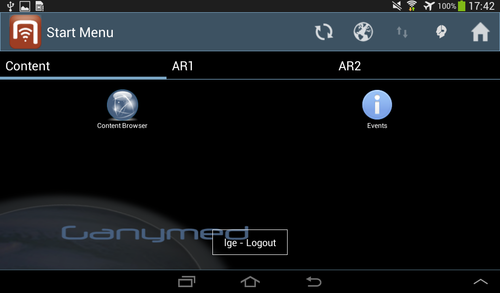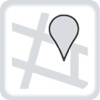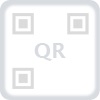Configure Start Screen Content
Introduction
The Dynamic Configurable start screen feature allows the UBIK Service engineer to tailor the buttons on the start screen according to the needs of the customer.
Setup
- The first step is to configure the start screen data using an xml in order for UBIK® to recognize the different tabs and buttons. The xml file, which must have the name css_config.xml, should be placed under SD_CARD/Android/data/APP_PACKAGE_NAME/files/UIConfigurations where
| Parameter | Purpose |
|---|---|
| SD_CARD | represents the root of the external storage of a device |
| APP_PACKAGE_NAME | is the concatenation of "com.augmensys.ubik." and the application name, e.g. demo, manualtest, companyname etc. |
- After the folder is configured, the next step is to validate the XML configuration file against the schema using an online validator. A solution can be found at Online XML Schema Validator. The schema used to validate against will be found inside the UBIK Folder and is named ConfigurableStartScreenSchema.
The following xml shows an example configuration (also can be downloaded as an xml file):
<Tab caption="Content">
<ContentBrowserButton caption="Content Browser"/>
<ContentBrowserButton caption="Events" UBIK-UID="31aaa5c9-85dd-4243-9cf8-89d712d32405" iconPath="events.png"/>
</Tab>
<Tab caption="AR1">
<MapsButton/>
<POIViewButton caption="AR View"/>
<CustomIntentButton caption="Map of Linz" iconPath="linz.png">
<TargetURI>
https://www.google.com/maps/place/Linz/@48.295065,14.327405,12z/data=!3m1!4b1!4m2!3m1!1s0x47739595fa99854d:0x7c53292c577975c4
</TargetURI>
</CustomIntentButton>
<TargetMapsButton caption="Flow Controller 213" UBIK-UID="2ccd91c0-9cee-42f3-9d1d-be745908457d"/>
</Tab>
<Tab caption="AR2">
<IDMarkerScanButton caption="ID Marker Scan"/>
<QRCodeScanButton caption="QR Code Scan"/>
<ConfigurableARButton caption="Configurable AR"/>
<ConfigurableImageMarkerButton caption="Configurable Image Marker"/>
<ARNavigationButton caption="Flow Controller 213" UBIK-UID="2ccd91c0-9cee-42f3-9d1d-be745908457d"/>
<NavigationMapsButton caption="Flow Controller 213" UBIK-UID="2ccd91c0-9cee-42f3-9d1d-be745908457d"/>
</Tab>
</StartScreenConfiguration>
Tab groups
The user can configure tab groups in the XML. They will be used as groupings for buttons.
Buttons
Buttons should be placed inside tab elements and can be parameterized. Buttons are configurable in terms of
- Icon
- Caption
- Group/tab
- Action + Parameters if needed
| The icons are specified by their relative paths under SD_CARD/Android/data/APP_PACKAGE_NAME/files/UIConfigurations/CSSButtonIcons |
The supported button types are as follows:
- Content Browser Button : Opens a content browser for displaying an object or the root if no object/uid is specified.
- Custom Intent Button (using a customized intent URI or target class) : Launches a certain application for the specified Intent.
- Maps Button : Opens UBIK® map.
- Target Maps Button : Opens UBIK® map for a target object.
- ID Marker Scan Button : Starts ID marker scanning.
- QR Scan Button : Starts QR code scanning.
- POI View Button : Opens UBIK® POI view.
- Configurable AR Button : Opens the markerless view.
- Configurable Image Marker Button : Opens the ID marker 3D view.
- AR Navigation POI View Button : Opens UBIK® POI view with the AR navigation support.
- AR Navigation Maps Button : Starts navigating to the specified object.
Configuration guidelines
- The maximum number of tabs is 6. Once this limit is exceeded, the configuration is invalid and won't be shown.
- The captions of tabs are optional. In case there's only one tab, the tab will be invisible.
- The buttons should always be nested inside tabs. Otherwise, the configuration is also invalid.
- Captions and icons of buttons are optional. Default values are used for the unspecified ones.
- While configuring the custom intent button, one should always specify one and only one of the target class and the target URI. Otherwise, the button is invalid and an error will be shown.
- The configuration of the UID parameter should always be specified for AR Navigation POI View Button, AR Navigation Maps Button and Target Maps Button.
Results
The result is that the tabs and buttons configured in the XML file will be visible and open the right activity once they are clicked.
The following screenshots demonstrates the results of the example XML configuration.
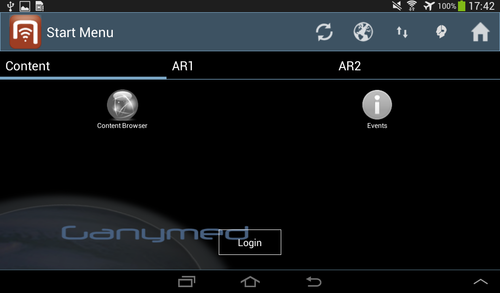
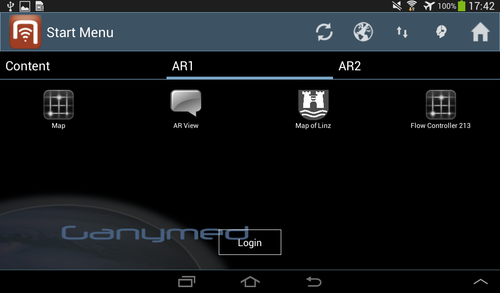

After users log in, the buttons are enabled and colored. Upon being clicked, they should trigger different actions.
